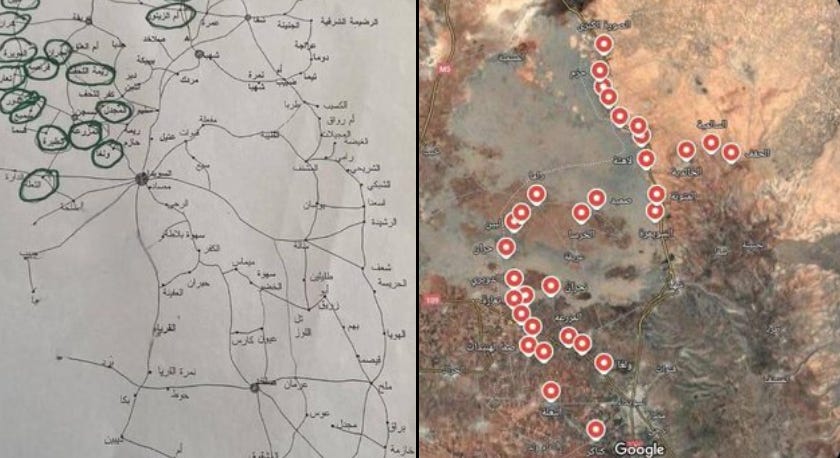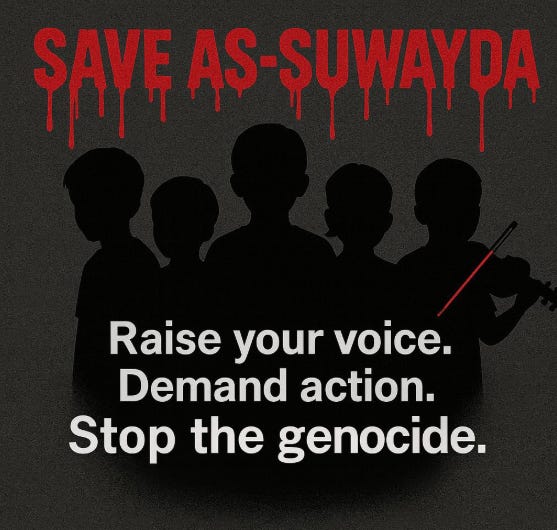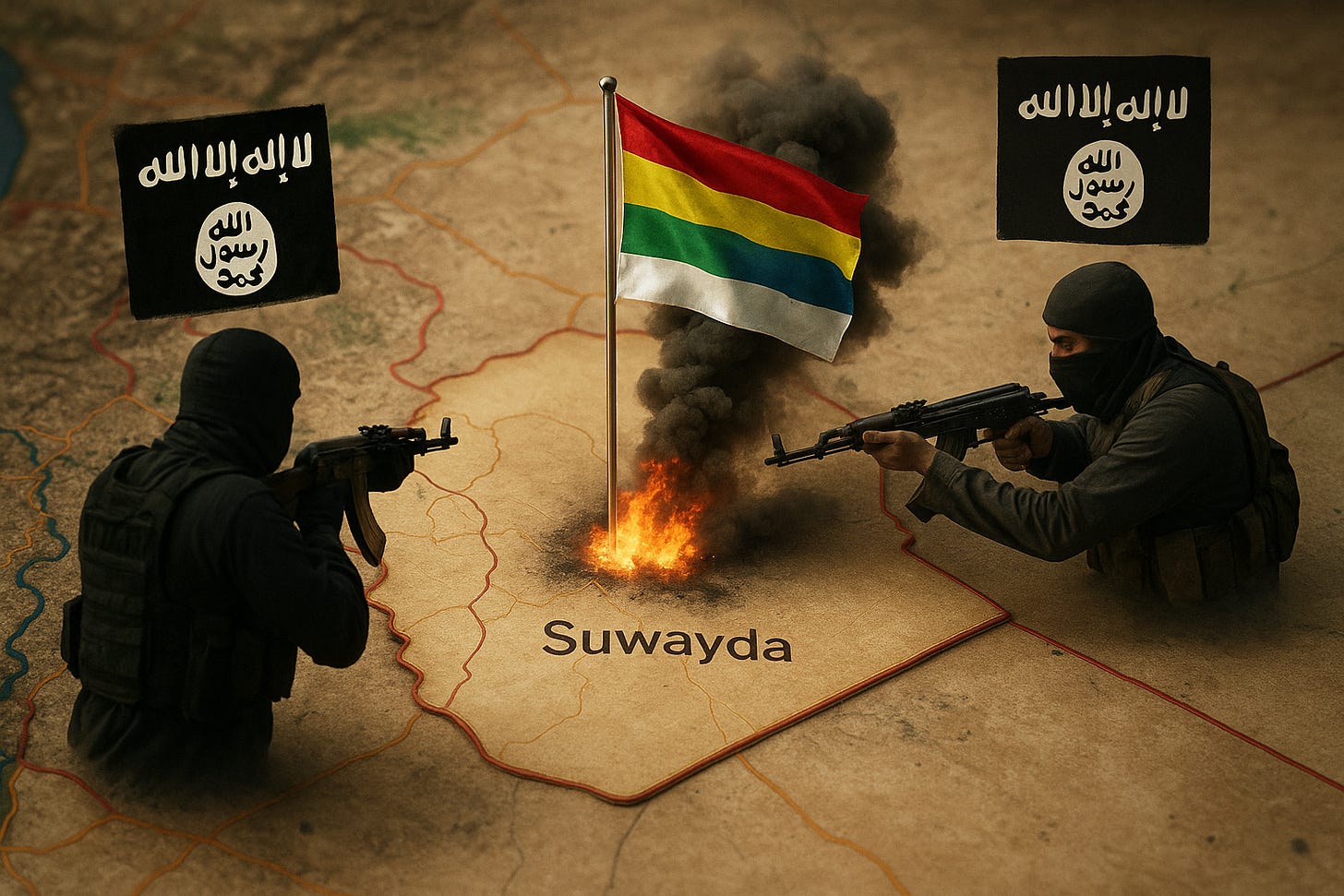Syria's Druze Under Fire as Government-Aligned Forces Resume Deadly Campaign
The ceasefire, brokered through intensive diplomatic efforts by the U.S., had been in place since July 19, 2025, following a week of devastating sectarian bloodshed that claimed hundreds of lives
Recent ceasefire violations in southern Syria have renewed international concern about the protection of religious minorities under the country's new leadership. On August 9, 2025, forces aligned with Hay'at Tahrir al-Sham (HTS) reportedly resumed hostilities against Druze communities in As-Suwayda(Sweida) Governorate, breaking a fragile truce that had been in place since mid-July.
Intelligence reports indicate that HTS forces launched attacks from their base in al-Mazraa using heavy weapons, while allied extremist elements, including suspected ISIS collaborators, participated in coordinated operations against Druze villages.
The breakdown of diplomatic efforts represents a significant escalation in what monitoring organizations describe as systematic persecution of Syria's vulnerable minorities under President Ahmed al-Sharaa's government. According to a comprehensive field report by the Al-Mishkat Center for Studies and obtained by Jewish Onliner, the scope of violence extends far beyond isolated incidents, constituting what appears to be coordinated demographic restructuring of the region.
Documented Scale of Devastation
Field documentation reveals the extensive nature of the campaign against Druze communities. According to the Al-Mishkat Center's assessment, the military operations resulted in the complete destruction of over 36 villages, with widespread burning of homes and systematic looting of markets and infrastructure. The organization confirmed that over 1,106 civilians have been confirmed killed, with field estimates suggesting the actual death toll may be several times higher due to ongoing searches in affected areas where mass executions occurred.
The humanitarian crisis has displaced approximately 228,000 people from affected villages in northern and western regions of As-Suwayda, representing complete evacuation of entire communities. Current conditions for displaced populations remain dire, with severe overcrowding in temporary shelters, critical shortages of water due to destruction of 98 wells, and disruption of basic services including healthcare, education, and sanitation.
The targeting of critical infrastructure demonstrates systematic intent to undermine community survival. Reports document deliberate destruction of the Umm al-Zaytoun grain silos and the Saraya Mill, major facilities essential for regional food security. Olive processing facilities, stone factories, and gas stations were systematically looted before being destroyed, eliminating productive capacity and economic foundations.

Government Forces and Extremist Elements Collaborate
The current crisis reflects broader concerns about the true nature of Syria's new leadership under President Ahmed al-Sharaa, whose government emerged from the former al-Qaeda-affiliated HTS organization. Despite public assurances of protecting minorities, documented evidence suggests systematic coordination between government-aligned forces and extremist elements in targeting Druze civilians.
Medical facilities have become specific targets, with the National Hospital in As-Suwayda suffering direct attacks that killed 22 medical staff members, including doctors, nurses, and support personnel.
Video evidence from conflict zones shows disturbing patterns of abuse including forced shaving of religiously significant facial hair and documented executions. The scale and coordination of these attacks have raised international alarm about potential sectarian cleansing reminiscent of ISIS methodologies during the organization's territorial control period.

Infrastructure Collapse and Humanitarian Crisis
The systematic destruction extends beyond immediate violence to comprehensive targeting of civilian infrastructure. Water system capacity has been reduced from 12,000 cubic meters per day to only 3,000 cubic meters, with 75% of water sources destroyed or rendered inoperable. This deliberate targeting of water infrastructure creates conditions for humanitarian catastrophe, particularly given the massive displacement of civilian populations.
Municipal services have collapsed entirely, with waste collection halted, road maintenance suspended, and administrative functions including birth registration, legal proceedings, and property documentation completely disrupted. The absence of basic governmental functions has created administrative vacuum that complicates humanitarian response and threatens long-term community viability.
Economic infrastructure has been systematically dismantled, with complete cessation of commercial, industrial, and agricultural activity. The disruption of salary payments to government employees for over two months has created additional hardship for families already facing displacement and property loss.

The Radical Leadership's Origins and International Support
At the center of this crisis stands Ahmed al-Sharaa, formerly known as Abu Mohammed al-Jolani, whose transformation from acknowledged terrorist with a U.S. bounty on his head to Syrian president has been marked by international skepticism. In 2011, ISIS founder Abu Bakr al-Baghdadi sent al-Jolani to Syria with substantial funding to establish Jabhat al-Nusra as a covert ISIS offshoot, which later pledged allegiance to al-Qaeda. Al Jolani can be seen taking the “death oath” below on X:
Turkey and Qatar's backing of al-Sharaa's rise to power has provided crucial resources and diplomatic cover necessary for consolidation of control, despite this support coming with implicit acceptance of his radical background and the violent elements within his coalition. Turkey's provision of training, intelligence, and logistical support to HTS forces while maintaining the organization's terrorist designation represents a significant policy contradiction.
The European Union and United States have begun normalizing relations with Syria's new government, but the systematic persecution of minorities raises fundamental questions about the regime's actual character and intentions. Recent Congressional testimony highlighted concerns that HTS shifts may simply represent tactical adaptations rather than genuine ideological transformation.



